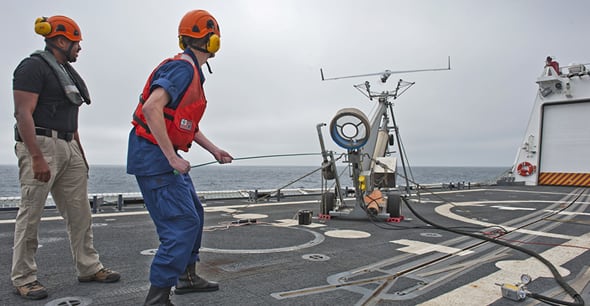The Coast Guard has been trying for years to field its own surveillance drone, but a lack of suitable choices and some expensive missteps have drawn the process out.
But with an infusion of funds in this year's budget, the guys at Aviation Forces is are developing a set of requirements for an unmanned aerial vehicle that can accomplish missions without having to be built from scratch.
The service needs something that can fly in terrible weather, at high altitudes and for days on end to aid in drug and migrant interdiction, search and rescue, and other missions, the unmanned aerial system program manager told an audience recently at the annual Sea Air Space Exposition outside Washington, D.C.
Without funds for its own acquisition program, the Coast Guard is hoping to pick up a modified version of an existing platform, or help facilitate a new drone through the Defense Department's Join Tactical UAV program office.
The problem, a recurring one for the Coast Guard, is a lack of funds to start an acquisition from scratch. So for now, Aviation Forces is looking to leverage another system that the Homeland Security or Defense Department already use.
"We're really agnostic with what it is — whether it's fixed-wing, rotary-wing," Lt. Cmdr. Dan Broadhurst said. "But what we need is a tactical, local asset that we can send out for up to 12 hours and probably up to about 5,000 feet."
The program has worked with a variety of platforms, including the Boeing ScanEagle, the MQ-9 Reaper/Guardian from Customs and Border Protection, the Marine Corps' Wasp Micro Air Vehicle and the Navy's MQ-8 Fire Scout. The latest contender is the fixed-wing Scan Eagle. and the service has funding to develop a drone for the national security cutter.
They all have their perks, Broadhurst said, but none is just right.
"Well, it's a two-trick pony," he said of the MQ-9 Reaper. "It does drugs and migrants very well, but it doesn't maybe do the rest of the Coast Guard's 11 missions quite as effectively."
Officials also would like drone coverage for missions like search and rescue, aids to navigation and living marine resources.
And the MQ-8 Fire Scout — which was a promising lead back when the Coast Guard thought a rotary-wing UAS was in its future — is expensive and hard to borrow for testing because they're so heavily deployed, Broadhurst said.
"There's a huge footprint that comes with it," he added. "The duration isn't very long. It comes back every six hours. That exhausts a crew, when we're talking about flying 12, 20 hours a day."
In addition to a lack of funding, he said, the service is waiting for technology to mature, so that someone will come up with a UAV that "can fly in bad weather, icy conditions, places that UAS currently aren't the most suited for."
Crash and burn
The service has been looking for a UAS since launching its Integrated Deepwater System Program in the 1990s, an effort to recapitalize all of the Coast Guard's boats and aircraft.
Out of that plan came the idea for a couple of unmanned systems, Broadhurst said, specifically the Bell HV-911 Eagle Eye, a vertical take-off tiltrotor UAV for the national security cutter.
"It required a lot of technology, a lot of cost. And it crashed during operational testing," he said. "So we find ourselves heavily invested in something that we have no product to show for it."
In 2007, the program decided to look to DoD for a new solution. After moving on from Fire Scout, testing began with the ScanEagle on the national security cutters Stratton and Bertholf.
In May of 2014, the ScanEagle deployed on Bertholf with a Helicopter Interdiction Tactical Squadron and completed its first successful drug bust.
A Navy P-3 Orion spotted a panga about 400 miles off the coast of Panama, Broadhurst said. When the piloted aircraft needed to turn around to refuel, the cutter moved into the area and launched the ScanEagle, which was able to stay on station to keep the surveillance going.
Eventually, a crew boarded the panga and found 570 kilos of cocaine, arresting three people.
"I think it's encouraging, if we can show Congress that something good is happening," Broadhurst said. "It might not be what they thought was happening, but if we can show them progress, they may be inclined to do it."
Broadhurst said the ScanEagle's fixed-wing model is what they're leaning toward now, but "if we had a rotary wing that could go for 48 hours, I'm all about it."
For now, they're hoping contractors will work with their DoD partners to develop something that the Coast Guard can piggyback onto, he said.
The service is working with a $6.3 million chunk of funding for fiscal year 2015, to develop system requirements specifically for a national security cutter-based UAV, Coast Guard spokesman Warrant Officer 3 Chad Saylor told Navy Times.
"We're eager. This program's been on ice for years and years," Broadhurst told Navy Times. "We have money now. It's exciting,"
Meghann Myers is the Pentagon bureau chief at Military Times. She covers operations, policy, personnel, leadership and other issues affecting service members.




